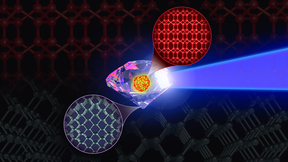Right on target
Dozens of employees gathered on Friday to celebrate two important milestones achieved by the NIF & Photon Science (NIF&PS) Directorate's and Weapons and Complex Integration (WCI) Directorate's Target Fabrication team.
Target Fabrication Manager Alex Hamza welcomed the crowd and kicked off the celebration by announcing the first of the milestones: This summer, the target fabrication team built the 10,000th target for the Omega Laser Facility at the University of Rochester's Laboratory for Laser Energetics (LLE).
"When I think about NIF, the two things that always come to my mind is the incredible engineering that happens on a large scale and on a small scale. Of course, today we are celebrating the small scale with targets. But the other thing is the partnerships," said Jeff Wisoff, principal associate director for NIF&PS.
"The Omega facility has been an incredible partner and LLE is incredibly important to us," he added. "Omega has provided the testing ground for a lot of things we wanted to do on NIF. It's a very enabling capability, and our success in building targets for that facility is part of that great partnership."
The second milestone announced by Hamza was the completion of the 500th cryogenic target for NIF. This is an important achievement because these millimeter-sized targets are complicated engineering marvels in tiny packages -- so complicated that targets were produced at a rate of one per year when the capability first got off the ground in 2005.
Design and fabrication is so complex because the precision required to perform under the extreme conditions experienced during an experiment on NIF -- temperatures of 180 million degrees Fahrenheit and pressures of 100 billion atmospheres. Components must be machined to within an accuracy of 1 micron (1 millionth of a meter) and many material structures and features can be no larger than 100 nanometers, which is just 1/1,000th the width of a human hair.
The capsule must have a smoothness tolerance approaching 1 nanometer, 1/100,000th the thickness of a human hair. Because surface debris can interfere with the uniformity of capsule heating and compression, dust particles greater than 5 microns in diameter on the capsule wall must be eliminated. Finally, the target temperature is held in the range of 18 to 20 kelvins (-427 to -424 degrees Fahrenheit) just before the laser shot so that an incredibly smooth and uniform solid hydrogen fuel layer can be formed.
Many different target designs exist -- for stockpile stewardship purposes, high-energy-density science and more. Today, the target fabrication team has the capability to produce 5-6 cryogenic targets per week and to produce more than 100 different types of targets each year.
"This is an incredible success story that has been so enabling in moving the science forward," Wisoff said. "We couldn't have done this without the incredible partnerships we've had with General Atomics and Schafer over the years. That partnership, and the partnerships that extend through our organization, is really what enables us to be successful."
Des Pilkington, leader of WCI's AX Division, was on hand to speak to one of those partnerships.
"We really push ourselves hard in WCI to think about what the right experiments are and what we want to do to test our ability to demonstrate that we have a predictive capability," he said. "In Target Fabrication, the response to some of these pushing needs from WCI has been incredible. I'd like to say thank you for everything that you've done, and everything you've delivered for us so far. I'm really looking forward to an exciting future with exciting challenges for us and for you."
Abbas Nikroo, leader of General Atomics' Target Fabrication Program, echoed those thanks. "It's been a pleasure working with you guys -- top quality people from the S&T team to the engineering team to the people on the floor who do the hard work of assembly," he said. "I see the transition we've made to streamlined production, where we've gone from one target a year to 5-6 targets a week. It's incredible, and is really built on the great work that everyone has done at all levels."
Contact
 Breanna Bishop
Breanna Bishop
[email protected]
(925) 423-9802
Related Links
National Ignition FacilityWeapons and Complex Integration
General Atomics
Schafer
Tags
National Ignition Facility and Photon ScienceNational Ignition Facility
Lasers and Optical S&T
Lasers
Featured Articles









